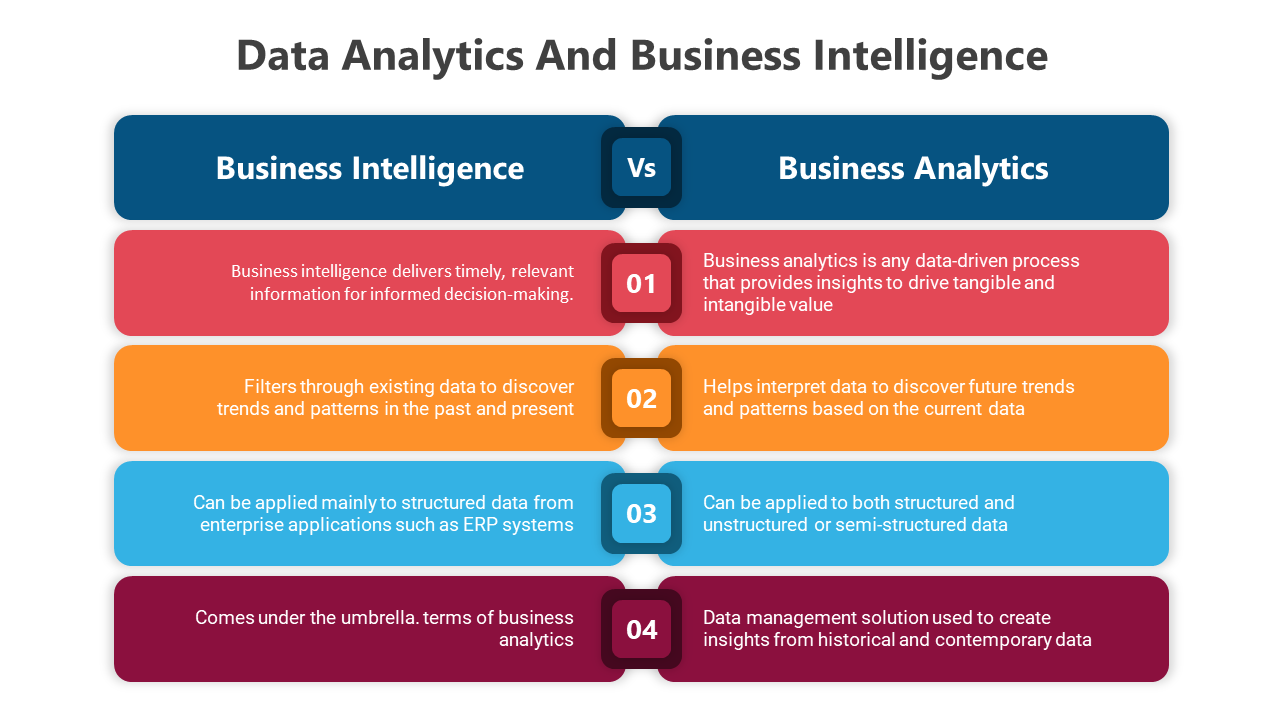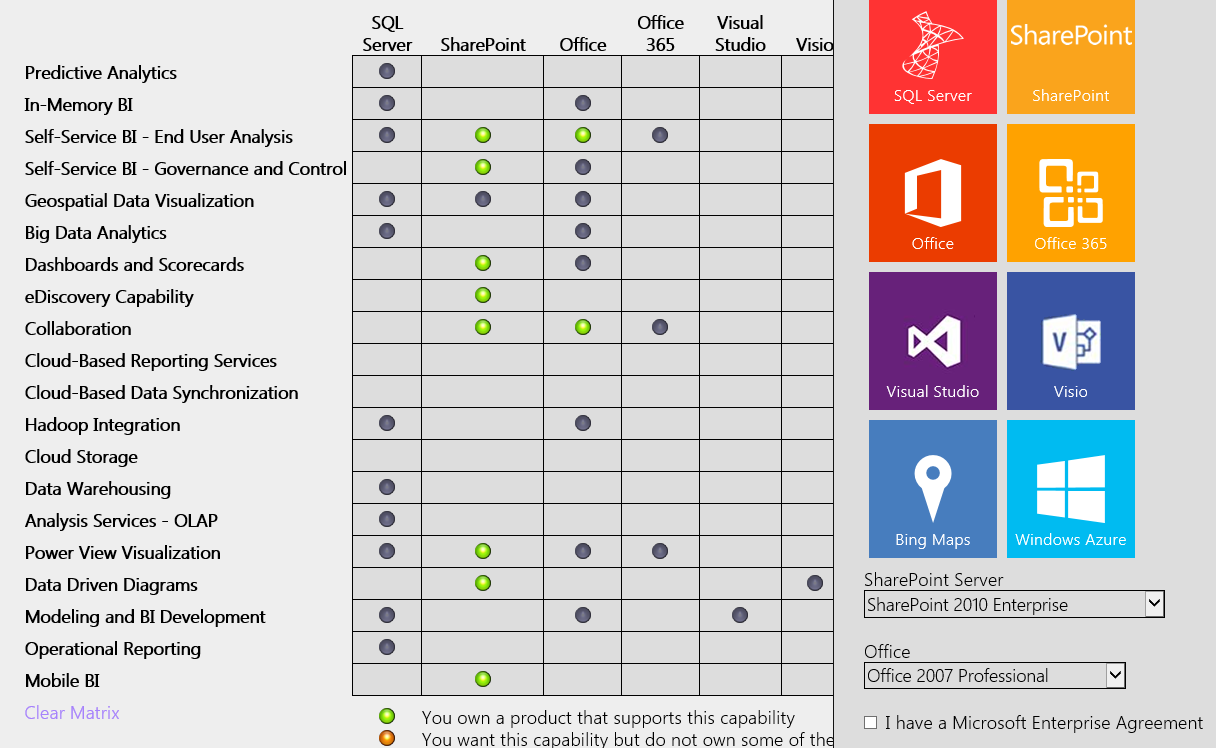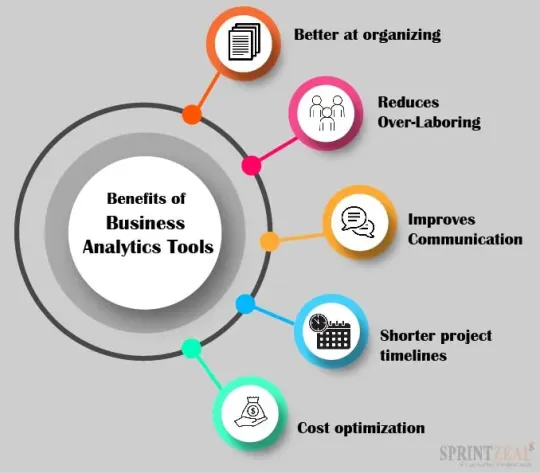Business Intelligence vs. Data Analytics
In the world of data, business intelligence (BI) and data analytics are like two sides of the same coin. But what exactly is the difference between the two? And which one is right for your business?
Let’s start with a simple analogy. BI is like a rearview mirror, providing information about the past and present so you can make better decisions. Data analytics, on the other hand, is like a windshield, helping you predict the future by uncovering insights from data.
Specifically, the realm of business intelligence encompasses dashboards, reports, and visualizations that offer a comprehensive view of your business’s performance. With BI, you can track key metrics, identify trends, and spot opportunities. Want to know how many customers visited your website last month? Or which products are selling the best? BI has the answers.
Data analytics, on the other hand, goes a step further. Instead of just providing information about the past and present, it helps you make predictions about the future. By analyzing historical data and identifying patterns, data analytics can tell you things like:
- Which customers are most likely to churn?
- What products are likely to be popular in the future?
- How can you optimize your marketing campaigns?
Of course, the choice between BI and data analytics depends on your specific business needs. If you’re looking for a way to improve your decision-making in the short term, BI is a great option. But if you want to gain a competitive edge by predicting the future, data analytics is the way to go.
Business Intelligence vs. Data Analytics: Unraveling the Nuances
In the fast-paced world of data-driven decision-making, business intelligence (BI) and data analytics have become indispensable tools for organizations looking to gain insights and stay ahead of the curve. However, while both disciplines involve working with data, they differ significantly in their purpose, approach, and applications.
Key Differences: A Deeper Dive into the Distinction
BI and data analytics are often used interchangeably, but there are key distinctions between the two. BI, as the name suggests, is primarily concerned with understanding past and present data to identify patterns and trends. It provides descriptive insights into historical data, helping businesses make informed decisions based on what has already happened. On the other hand, data analytics goes a step further by leveraging advanced statistical techniques to uncover hidden patterns and make predictions about the future. It’s predictive and forward-looking, providing organizations with actionable insights to optimize their operations and capitalize on opportunities.
Another key difference lies in the scope of the data being analyzed. BI typically focuses on structured data from internal sources, such as financial statements, sales reports, and customer data. This data is often well-organized and easy to manipulate. Data analytics, however, can handle both structured and unstructured data from a wide range of sources, including external data from social media, website traffic, and market research. This broader scope allows data analysts to gain insights from a more holistic perspective.
Finally, the end goal of BI and data analytics differs. BI aims to provide insights that help businesses understand their current performance and identify areas for improvement. It supports tactical decision-making and helps businesses optimize their day-to-day operations. Data analytics, on the other hand, is more strategic in nature. It helps organizations make long-term decisions, anticipate market trends, and develop innovative solutions to drive growth.
In essence, BI is like a rearview mirror, providing a clear picture of where a business has been. Data analytics, on the other hand, is akin to a GPS, helping organizations navigate the future and make informed decisions that will keep them on the path to success.
Business Intelligence vs. Data Analytics: Know the Difference?
In the realm of data, two enigmatic terms often dance around each other: business intelligence (BI) and data analytics. While they may sound like synonyms, there’s a subtle distinction that differentiates these two data powerhouses.
Function
Where business intelligence serves as the culinary master, transforming raw data into delectable insights for strategic decision-making, data analytics plays the role of a detective, scrutinizing data for patterns, trends, and any suspicious anomalies that could optimize outcomes. BI simplifies the labyrinth of complex data into digestible formats, making it easy for decision-makers to navigate the ever-changing business landscape. On the other hand, data analytics delves deeper, unearthing hidden patterns and trends, and highlighting any out-of-the-ordinary happenings that could impact business performance.
Applications
BI’s strength lies in transforming raw data into meaningful visuals, dashboards, and reports, which provide a comprehensive overview of business performance. It’s the go-to tool for executives and managers who need to stay on top of key metrics and make informed decisions. Data analytics, on the other hand, digs deeper, using sophisticated models and algorithms to uncover correlations, dependencies, and patterns within data. This in-depth analysis empowers businesses to identify areas for improvement, optimize processes, and predict future trends.
Value to Organizations
Both BI and data analytics are indispensable assets for organizations that want to make data-driven decisions. BI provides a clear view of the present, enabling businesses to track performance and identify areas for improvement. Data analytics, on the other hand, offers a glimpse into the future, helping businesses anticipate trends, adapt to changes, and stay ahead of the competition. By combining the insights from both BI and data analytics, organizations can gain a comprehensive understanding of their data, empowering them to make informed decisions that drive growth and success.
Business Intelligence vs Data Analytics: Which One Do You Need?
When it comes to making data-driven decisions, businesses have two main options: business intelligence (BI) and data analytics. But what’s the difference between the two? And which one is right for you?
In a nutshell, BI is all about turning raw data into actionable insights. BI tools include dashboards, reporting, and ad hoc queries, which allow users to quickly and easily explore their data and identify trends and patterns.
Data analytics, on the other hand, is more about using statistical modeling, machine learning, and predictive analytics to uncover hidden insights from data. Data analytics tools can be used to identify customer churn, predict sales trends, and optimize marketing campaigns.
So, which one do you need? If you’re looking for a quick and easy way to get insights from your data, then BI is a good option. But if you need to uncover more complex insights or make predictions about the future, then data analytics is the way to go.
Technology
As mentioned above, BI tools include dashboards, reporting, and ad hoc queries. Dashboards provide a real-time view of your data, while reports can be used to track trends over time. Ad hoc queries allow you to ask specific questions about your data.
Data analytics tools, on the other hand, use more sophisticated techniques such as statistical modeling, machine learning, and predictive analytics. Statistical modeling can be used to identify relationships between different variables, while machine learning can be used to build models that can predict future outcomes. Predictive analytics can be used to identify customers who are at risk of churning or to predict sales trends.
Ultimately, the best technology for your business will depend on your specific needs. If you need a quick and easy way to get insights from your data, then BI is a good option. But if you need to uncover more complex insights or make predictions about the future, then data analytics is the way to go.
Business Intelligence vs. Data Analytics: An In-Depth Comparison
In today’s data-driven world, businesses are constantly seeking ways to make sense of the vast amounts of information at their disposal. This is where business intelligence (BI) and data analytics come in. While both disciplines involve working with data, they differ in their scope and objectives. BI focuses on providing insights into current and past business performance, while data analytics delves into predictive modeling and forecasting.
What is Business Intelligence?
BI is a set of tools and technologies that help businesses gather, organize, and analyze data in order to make informed decisions. It’s like a dashboard that gives you a snapshot of your business, showing you key metrics and trends that can inform your strategy.
What is Data Analytics?
Data analytics is a more advanced form of BI that uses statistical modeling, machine learning, and other techniques to predict future outcomes. It’s like a crystal ball that can help you identify patterns and trends, and make predictions about what might happen next.
Applications
BI and data analytics have a wide range of applications across various industries.
- BI is commonly used for sales forecasting, financial analysis, and customer segmentation.
- Data analytics finds applications in risk assessment, fraud detection, , and churn prediction.
Benefits
Both BI and data analytics offer a number of benefits to businesses, including:
- Improved decision-making
- Increased efficiency
- Reduced costs
- Enhanced customer satisfaction
Choosing the Right Solution
Choosing between BI and data analytics depends on your specific business needs. If you need real-time insights into your business performance, BI is a good option. If you’re looking to predict future trends and make strategic decisions, data analytics is a better choice.
Conclusion
BI and data analytics are both essential tools for businesses that want to make the most of their data. By understanding the difference between the two and choosing the right solution for your needs, you can gain valuable insights that can help you grow your business.
**Business Intelligence vs. Data Analytics: Empowering Informed Business Decisions**
In a competitive business landscape, leveraging data to gain insights is essential. Business intelligence (BI) and data analytics are two powerful tools that help organizations make informed decisions, but they serve distinct roles.
Business Intelligence: Supporting Tactical Decision-Making
Think of business intelligence as a trusty map, guiding daily operations and tactical decision-making. It crunches historical and current data to provide real-time insights, helping businesses optimize processes, identify sales opportunities, and respond swiftly to market changes. Like a well-seasoned hiker, BI makes sure you’re on the right track with every step you take.
Data Analytics: Fueling Strategic Planning
Data analytics, on the other hand, is akin to an intrepid explorer venturing into uncharted territory. It delves deep into large and complex datasets, uncovering hidden patterns and trends that can inform long-term initiatives and strategic planning. Through predictive modeling and scenario analysis, data analytics helps businesses anticipate future market conditions, identify growth opportunities, and gain a competitive edge.
Role in Organizations
BI supports business operations and tactical decision-making, while data analytics empowers strategic planning and long-term initiatives. BI provides real-time insights for day-to-day operations, such as optimizing inventory, targeting marketing campaigns, and monitoring customer satisfaction. Data analytics, on the other hand, offers a broader perspective, informing strategic investments, product development, and market expansion.
Skill Sets
To master BI, you need a solid foundation in data extraction, visualization, and reporting. Data analytics, however, demands more advanced skills, including statistical modeling, machine learning, and predictive analytics. Both BI and data analytics professionals must possess strong analytical and problem-solving abilities.
Tools and Technologies
A wide range of tools are available for BI and data analytics. BI tools, such as Business Objects and Tableau, enable data visualization and reporting. Data analytics platforms, such as Apache Spark and Hadoop, are designed for handling and analyzing large and complex datasets.
Conclusion
Business intelligence and data analytics are indispensable tools for data-driven organizations. By understanding their distinct roles and leveraging their capabilities, businesses can make informed decisions, adapt to market changes, and gain a competitive edge. In the ever-evolving world of data, these two tools are the GPS and compass that guide companies towards success.
**Business Intelligence vs. Data Analytics: Know the Difference**
Business intelligence (BI) and data analytics often get lumped together, but they’re actually two distinct disciplines with different goals, methods, and audiences. Understanding the difference between the two can help you decide which one is right for your organization.
**What’s the Difference?**
BI is a set of tools and technologies that helps organizations turn their raw data into meaningful information that can be used to make better decisions. BI systems collect data from a variety of sources, such as sales records, customer surveys, and financial statements, and then organize and analyze it to identify trends and patterns. This information can then be used to create reports, dashboards, and other visualizations that make it easy for decision-makers to understand.
Data analytics, on the other hand, is the process of examining data to extract insights that can be used to improve business outcomes. Data analytics uses a variety of statistical and machine learning techniques to uncover hidden trends and relationships in data. This information can then be used to make predictions, identify opportunities, and develop new strategies.
**User Base**
BI targets a broader audience of business stakeholders, while data analytics primarily caters to analysts, data scientists, and technical experts. BI systems are designed to be easy to use, even for people who don’t have a background in data analysis. Data analytics tools, on the other hand, require more technical expertise to use effectively.
**Tools and Technologies**
BI systems typically use a variety of tools and technologies to collect, organize, and analyze data. These tools include data warehouses, data mining software, and reporting tools. Data analytics systems, on the other hand, typically use more sophisticated tools and techniques, such as statistical software, machine learning algorithms, and data visualization tools.
**Business Value**
BI and data analytics can both provide significant value to organizations. BI can help organizations improve their decision-making, track their performance, and identify areas for improvement. Data analytics can help organizations uncover new insights, predict future trends, and develop new strategies.
**Choosing the Right Solution**
The best way to decide which solution is right for your organization is to consider your specific needs and goals. If you need a solution that is easy to use and can be used by a variety of stakeholders, then a BI system is likely a good option. If you need a solution that can provide more in-depth analysis and insights, then a data analytics system is likely a better choice. BI and data analytics are not mutually exclusive. Many organizations use both solutions to get the most value from their data.
Saran Video Seputar : business intelligence vs data analytics




Leave a Reply